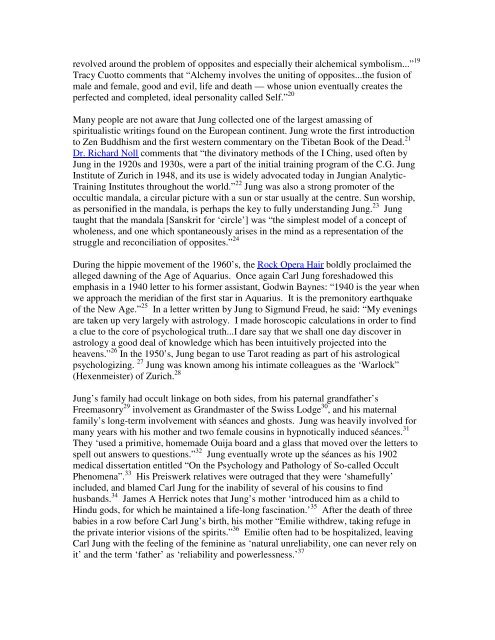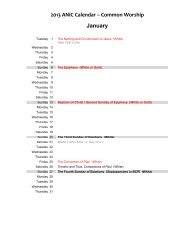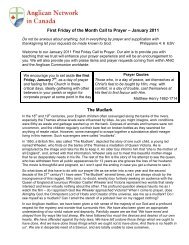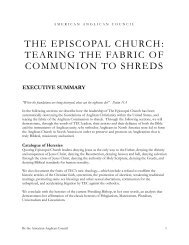Carl Jung and the Gnostic Reconciliation of Gender Opposites
Carl Jung and the Gnostic Reconciliation of Gender Opposites
Carl Jung and the Gnostic Reconciliation of Gender Opposites
You also want an ePaper? Increase the reach of your titles
YUMPU automatically turns print PDFs into web optimized ePapers that Google loves.
evolved around <strong>the</strong> problem <strong>of</strong> opposites <strong>and</strong> especially <strong>the</strong>ir alchemical symbolism...” 19<br />
Tracy Cuotto comments that “Alchemy involves <strong>the</strong> uniting <strong>of</strong> opposites...<strong>the</strong> fusion <strong>of</strong><br />
male <strong>and</strong> female, good <strong>and</strong> evil, life <strong>and</strong> death — whose union eventually creates <strong>the</strong><br />
perfected <strong>and</strong> completed, ideal personality called Self.” 20<br />
Many people are not aware that <strong>Jung</strong> collected one <strong>of</strong> <strong>the</strong> largest amassing <strong>of</strong><br />
spiritualistic writings found on <strong>the</strong> European continent. <strong>Jung</strong> wrote <strong>the</strong> first introduction<br />
to Zen Buddhism <strong>and</strong> <strong>the</strong> first western commentary on <strong>the</strong> Tibetan Book <strong>of</strong> <strong>the</strong> Dead. 21<br />
Dr. Richard Noll comments that “<strong>the</strong> divinatory methods <strong>of</strong> <strong>the</strong> I Ching, used <strong>of</strong>ten by<br />
<strong>Jung</strong> in <strong>the</strong> 1920s <strong>and</strong> 1930s, were a part <strong>of</strong> <strong>the</strong> initial training program <strong>of</strong> <strong>the</strong> C.G. <strong>Jung</strong><br />
Institute <strong>of</strong> Zurich in 1948, <strong>and</strong> its use is widely advocated today in <strong>Jung</strong>ian Analytic-<br />
Training Institutes throughout <strong>the</strong> world.” 22 <strong>Jung</strong> was also a strong promoter <strong>of</strong> <strong>the</strong><br />
occultic m<strong>and</strong>ala, a circular picture with a sun or star usually at <strong>the</strong> centre. Sun worship,<br />
as personified in <strong>the</strong> m<strong>and</strong>ala, is perhaps <strong>the</strong> key to fully underst<strong>and</strong>ing <strong>Jung</strong>. 23 <strong>Jung</strong><br />
taught that <strong>the</strong> m<strong>and</strong>ala [Sanskrit for ‘circle’] was “<strong>the</strong> simplest model <strong>of</strong> a concept <strong>of</strong><br />
wholeness, <strong>and</strong> one which spontaneously arises in <strong>the</strong> mind as a representation <strong>of</strong> <strong>the</strong><br />
struggle <strong>and</strong> reconciliation <strong>of</strong> opposites.” 24<br />
During <strong>the</strong> hippie movement <strong>of</strong> <strong>the</strong> 1960’s, <strong>the</strong> Rock Opera Hair boldly proclaimed <strong>the</strong><br />
alleged dawning <strong>of</strong> <strong>the</strong> Age <strong>of</strong> Aquarius. Once again <strong>Carl</strong> <strong>Jung</strong> foreshadowed this<br />
emphasis in a 1940 letter to his former assistant, Godwin Baynes: “1940 is <strong>the</strong> year when<br />
we approach <strong>the</strong> meridian <strong>of</strong> <strong>the</strong> first star in Aquarius. It is <strong>the</strong> premonitory earthquake<br />
<strong>of</strong> <strong>the</strong> New Age.” 25 In a letter written by <strong>Jung</strong> to Sigmund Freud, he said: “My evenings<br />
are taken up very largely with astrology. I made horoscopic calculations in order to find<br />
a clue to <strong>the</strong> core <strong>of</strong> psychological truth...I dare say that we shall one day discover in<br />
astrology a good deal <strong>of</strong> knowledge which has been intuitively projected into <strong>the</strong><br />
heavens.” 26 In <strong>the</strong> 1950’s, <strong>Jung</strong> began to use Tarot reading as part <strong>of</strong> his astrological<br />
psychologizing. 27 <strong>Jung</strong> was known among his intimate colleagues as <strong>the</strong> ‘Warlock”<br />
(Hexenmeister) <strong>of</strong> Zurich. 28<br />
<strong>Jung</strong>’s family had occult linkage on both sides, from his paternal gr<strong>and</strong>fa<strong>the</strong>r’s<br />
Freemasonry 29 involvement as Gr<strong>and</strong>master <strong>of</strong> <strong>the</strong> Swiss Lodge 30 , <strong>and</strong> his maternal<br />
family’s long-term involvement with séances <strong>and</strong> ghosts. <strong>Jung</strong> was heavily involved for<br />
many years with his mo<strong>the</strong>r <strong>and</strong> two female cousins in hypnotically induced séances. 31<br />
They ‘used a primitive, homemade Ouija board <strong>and</strong> a glass that moved over <strong>the</strong> letters to<br />
spell out answers to questions.” 32 <strong>Jung</strong> eventually wrote up <strong>the</strong> séances as his 1902<br />
medical dissertation entitled “On <strong>the</strong> Psychology <strong>and</strong> Pathology <strong>of</strong> So-called Occult<br />
Phenomena”. 33 His Preiswerk relatives were outraged that <strong>the</strong>y were ‘shamefully’<br />
included, <strong>and</strong> blamed <strong>Carl</strong> <strong>Jung</strong> for <strong>the</strong> inability <strong>of</strong> several <strong>of</strong> his cousins to find<br />
husb<strong>and</strong>s. 34 James A Herrick notes that <strong>Jung</strong>’s mo<strong>the</strong>r ‘introduced him as a child to<br />
Hindu gods, for which he maintained a life-long fascination.’ 35 After <strong>the</strong> death <strong>of</strong> three<br />
babies in a row before <strong>Carl</strong> <strong>Jung</strong>’s birth, his mo<strong>the</strong>r “Emilie withdrew, taking refuge in<br />
<strong>the</strong> private interior visions <strong>of</strong> <strong>the</strong> spirits.” 36 Emilie <strong>of</strong>ten had to be hospitalized, leaving<br />
<strong>Carl</strong> <strong>Jung</strong> with <strong>the</strong> feeling <strong>of</strong> <strong>the</strong> feminine as ‘natural unreliability, one can never rely on<br />
it’ <strong>and</strong> <strong>the</strong> term ‘fa<strong>the</strong>r’ as ‘reliability <strong>and</strong> powerlessness.’ 37









